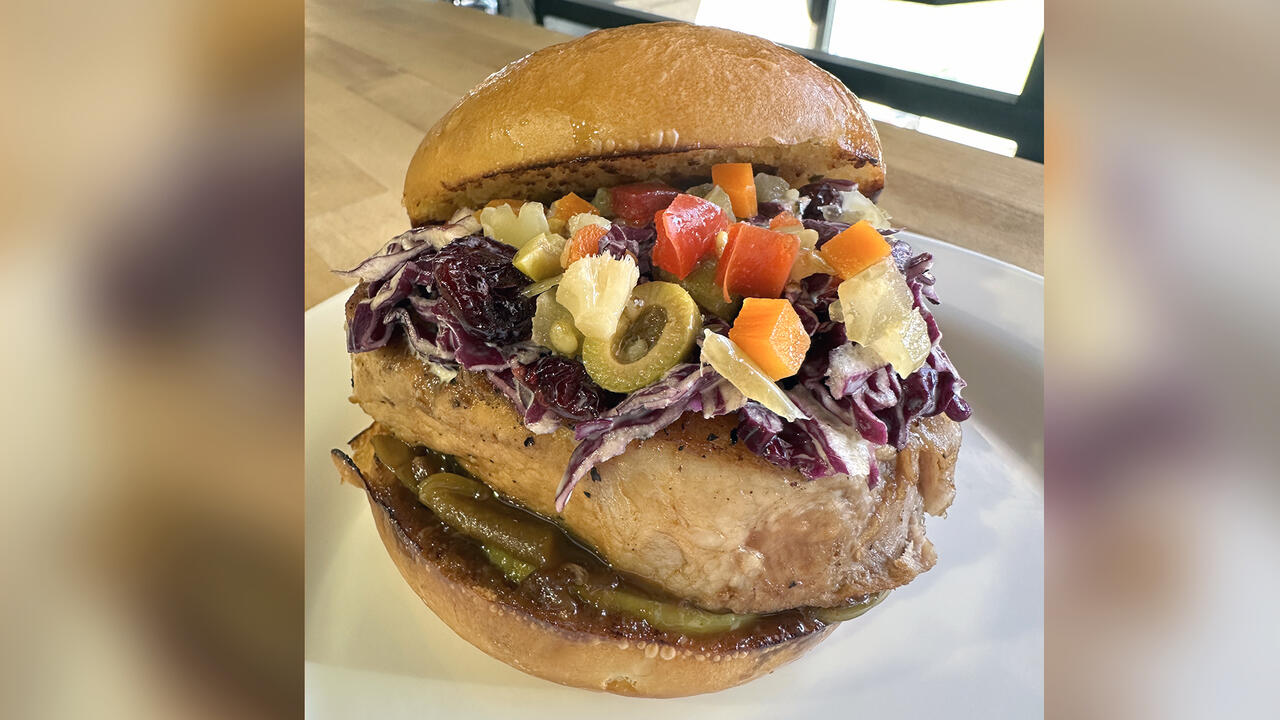

Why You Might Want to Consider Brining Your Meat Rather Than Mar…

Q&A with Organizational Pro Peter Walsh + Dermatologist Shares A…

Actor Hank Azaria + Freezer Meals + Artichokes 2 Ways with Rach

See Inside Barbara Corcoran's Stunning NY Apartment + It's Steak…

The Best Moments From 17 Seasons of the Show Will Make You Laugh…

How to Make Chicken and Lobster Piccata | Richard Blais

Donnie Wahlberg Spills Details About NKOTB's First Ever Conventi…

Donnie Wahlberg + Jenny McCarthy Say Rach Is Such a "Joy" + Look…

How to Make Crabby Carbonara | Rachael Ray

Rach Chats "Firsts" In Flashback From Our First Episode Ever In …

How to Make Tortilla with Potatoes, Piquillo Peppers and Mancheg…

How to Make Sesame Cookies | Buddy Valastro

How to Make Apple-Cider Braised Pork Chop Sandwiches with Onion …

Rach's Chef Pals Say Goodbye to Show in Surprise Video Message

Celebrity Guests Send Farewell Messages After 17 Seasons of the …

Andrew McCarthy Teases Upcoming "Brat Pack" Reunion Special

How to Make Spanakopipasta | Rachael Ray

Michelle Obama Toasts Rach's 17 Years on the Air With a Heartfel…

How to Make Shrimp Burgers | Jacques Pepin

Andrew McCarthy Chokes Up Discussing Emotional Trip to Spain wit…

Celebrity Guests Send Farewell Messages After 17 Seasons of the …
Need to up your grilling game? Look no further!
Meathead Goldwyn is a BBQ expert and author of the New York Times-bestselling book Meathead: The Science of Great Barbecue and Grilling.
He's revealing five of the most common mistakes people make when it comes to grilling steak and chicken — and what you should do instead.
Mistake #1: Marinating Your Steak
What To Do Instead: Dry Brine Your Steak
According to the expert, marinades don't actually perform the way we think they do.
"They're great, but they don't soak into the meat," he says. "They're primarily affecting the surface of the meat."
Meathead places marinades in the same categories as rubs and sauces. If you want the flavor to really penetrate your meat down to the center, Meathead suggests brining the meat instead of marinating it.
"Brines get down in there — and not only that, they change the structure of the protein so they help hold onto the moisture," he explains.
There's a technique called dry brining, which simply means salting the meat a few hours before you cook it.
Mistake #2: ONLY Marinating Your Chicken
What To Do Instead: Gash Your Chicken Before You Marinate It
"Chicken is a little more friendly to marinades. It does soak in a little better," Meathead says. "If you want to get some flavor down in, there's a technique we called gashing."
Use a knife to create gashes, or pockets, in the chicken for the marinade flavor to more easily soak into.
Watch the video above to see Meathead demonstrate the technique.
RELATED: THIS Is The Minimum Amount of Time You Should Marinate Meat
Mistake #3: Searing Your Meat To Seal In Juices
What To Do Instead: Brown Your Meat To Seal In Flavor
3 Myths About Steak — Debunked

3 Myths About Steak — Debunked

Q&A with Organizational Pro Peter Walsh + Dermatologist Shares A…

Actor Hank Azaria + Freezer Meals + Artichokes 2 Ways with Rach

See Inside Barbara Corcoran's Stunning NY Apartment + It's Steak…

The Best Moments From 17 Seasons of the Show Will Make You Laugh…

How to Make Chicken and Lobster Piccata | Richard Blais

Donnie Wahlberg Spills Details About NKOTB's First Ever Conventi…

Donnie Wahlberg + Jenny McCarthy Say Rach Is Such a "Joy" + Look…

How to Make Crabby Carbonara | Rachael Ray

Rach Chats "Firsts" In Flashback From Our First Episode Ever In …

How to Make Tortilla with Potatoes, Piquillo Peppers and Mancheg…

How to Make Sesame Cookies | Buddy Valastro

How to Make Apple-Cider Braised Pork Chop Sandwiches with Onion …

Rach's Chef Pals Say Goodbye to Show in Surprise Video Message

Celebrity Guests Send Farewell Messages After 17 Seasons of the …

Andrew McCarthy Teases Upcoming "Brat Pack" Reunion Special

How to Make Spanakopipasta | Rachael Ray

Michelle Obama Toasts Rach's 17 Years on the Air With a Heartfel…

How to Make Shrimp Burgers | Jacques Pepin

Andrew McCarthy Chokes Up Discussing Emotional Trip to Spain wit…

Celebrity Guests Send Farewell Messages After 17 Seasons of the …
The idea that searing meat seals in the juices is actually a myth, Meathead reveals.
He shows two steaks cooked to the same temperature — one that was seared, or browned, first and one that was not seared at all.
They came out at almost exactly the same weight, proving that searing didn't hold in much more juice at all.
You still do want to sear, though. The browning you see is actually something called the "Maillard reaction," which is "absolutely necessary for flavor," Meathead says.
And speaking of, Meathead also busted another common myth. "Everybody calls this juice that comes running out of a steak … blood. But it's not blood. It's water and it's been colored by a pigment called myoglobin."
RELATED: Richard Blais Shares His Dos + Don'ts of How to Sear the Most Mouthwatering Steak
Mistake #4: Turning Your Steak to Get Perfect Cross-Hatch Grill Marks
What To Do Instead: Turn Your Steak Less So It Cooks Evenly
Often, grill packaging and advertising shows cooked steaks with cross hatch grill marks. You have to turn the steak to get the grill marks, but according to the expert, the lighter meat in between the grill marks is "unfulfilled potential."
"When you do a lot of turning, what happens is the heat comes out, rather than going down in, and you don't overcook the meat," he says.
You'll get a lot more flavor on the surface by simply turning your steak, rather than trying to make those picturesque grill marks in it.
Mistake #5: Cutting Into Meat To Tell If It's Done
What To Do Instead: Use A Digital Thermometer For Perfect Meat, Every Time
How To Get the Perfect Steak Every Time

How To Get the Perfect Steak Every Time

Q&A with Organizational Pro Peter Walsh + Dermatologist Shares A…

Actor Hank Azaria + Freezer Meals + Artichokes 2 Ways with Rach

See Inside Barbara Corcoran's Stunning NY Apartment + It's Steak…

How to Make Chicken and Lobster Piccata | Richard Blais

Donnie Wahlberg Spills Details About NKOTB's First Ever Conventi…

Donnie Wahlberg + Jenny McCarthy Say Rach Is Such a "Joy" + Look…

The Best Moments From 17 Seasons of the Show Will Make You Laugh…

How to Make Crabby Carbonara | Rachael Ray

Rach Chats "Firsts" In Flashback From Our First Episode Ever In …

How to Make Apple-Cider Braised Pork Chop Sandwiches with Onion …

Rach's Chef Pals Say Goodbye to Show in Surprise Video Message

How to Make Sesame Cookies | Buddy Valastro

How to Make Tortilla with Potatoes, Piquillo Peppers and Mancheg…

How to Make Shrimp Burgers | Jacques Pepin

How to Make Spanakopipasta | Rachael Ray

Andrew McCarthy Chokes Up Discussing Emotional Trip to Spain wit…

Celebrity Guests Send Farewell Messages After 17 Seasons of the …

Celebrity Guests Send Farewell Messages After 17 Seasons of the …

Andrew McCarthy Teases Upcoming "Brat Pack" Reunion Special

Michelle Obama Toasts Rach's 17 Years on the Air With a Heartfel…
A lot of people simply cut into their meat to tell if it's done, but this isn't a safe method, according to Meathead.
"Actually, the color can change as it hits oxygen," he says. "The only way to tell when meat is done properly — and not only to your liking, but safe — is with a digital thermometer."
RELATED: These Are The Exact Grilling Times For Perfectly Cooked Sausage & Chicken
All you have to do is stick it in the meat and you'll get an exact reading.
"You need one of these," the expert says.


